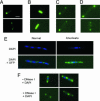A bacterial group II intron-encoded reverse transcriptase localizes to cellular poles
- PMID: 16186487
- PMCID: PMC1283441
- DOI: 10.1073/pnas.0507057102
A bacterial group II intron-encoded reverse transcriptase localizes to cellular poles
Abstract
The Lactococcus lactis Ll.LtrB group II intron encodes a reverse transcriptase (LtrA protein) that binds the intron RNA to promote RNA splicing and intron mobility. Here, we used LtrA-GFP fusions and immunofluorescence microscopy to show that LtrA localizes to cellular poles in Escherichia coli and Lactococcus lactis. This polar localization occurs with or without coexpression of Ll.LtrB intron RNA, is observed over a wide range of cellular growth rates and expression levels, and is independent of replication origin function. The same localization pattern was found for three nonoverlapping LtrA subsegments, possibly reflecting dependence on common redundant signals and/or protein physical properties. When coexpressed in E. coli, LtrA interferes with the polar localization of the Shigella IcsA protein, which mediates polarized actin tail assembly, suggesting competition for a common localization determinant. The polar localization of LtrA could account for the preferential insertion of the Ll.LtrB intron in the origin and terminus regions of the E. coli chromosome, may facilitate access to exposed DNA in these regions, and could potentially link group II intron mobility to the host DNA replication and/or cell division machinery.
Figures







Similar articles
-
Binding of a group II intron-encoded reverse transcriptase/maturase to its high affinity intron RNA binding site involves sequence-specific recognition and autoregulates translation.J Mol Biol. 2002 Apr 26;318(2):287-303. doi: 10.1016/S0022-2836(02)00054-2. J Mol Biol. 2002. PMID: 12051838
-
Bipolar localization of the group II intron Ll.LtrB is maintained in Escherichia coli deficient in nucleoid condensation, chromosome partitioning and DNA replication.Mol Microbiol. 2006 Nov;62(3):709-22. doi: 10.1111/j.1365-2958.2006.05419.x. Epub 2006 Sep 27. Mol Microbiol. 2006. PMID: 17005014
-
Group II intron protein localization and insertion sites are affected by polyphosphate.PLoS Biol. 2008 Jun 24;6(6):e150. doi: 10.1371/journal.pbio.0060150. PLoS Biol. 2008. PMID: 18593213 Free PMC article.
-
Group II introns and expression of conjugative transfer functions in lactic acid bacteria.Antonie Van Leeuwenhoek. 1999 Jul-Nov;76(1-4):77-88. Antonie Van Leeuwenhoek. 1999. PMID: 10532373 Review.
-
Insights into the strategies used by related group II introns to adapt successfully for the colonisation of a bacterial genome.RNA Biol. 2014;11(8):1061-71. doi: 10.4161/rna.32092. Epub 2014 Oct 31. RNA Biol. 2014. PMID: 25482895 Free PMC article. Review.
Cited by
-
Profile of Alan M. Lambowitz.Proc Natl Acad Sci U S A. 2006 Feb 7;103(6):1669-71. doi: 10.1073/pnas.0508183103. Epub 2006 Jan 31. Proc Natl Acad Sci U S A. 2006. PMID: 16449389 Free PMC article. No abstract available.
-
Localization of a bacterial group II intron-encoded protein in eukaryotic nuclear splicing-related cell compartments.PLoS One. 2013 Dec 31;8(12):e84056. doi: 10.1371/journal.pone.0084056. eCollection 2013. PLoS One. 2013. PMID: 24391881 Free PMC article.
-
Enhanced group II intron retrohoming in magnesium-deficient Escherichia coli via selection of mutations in the ribozyme core.Proc Natl Acad Sci U S A. 2013 Oct 1;110(40):E3800-9. doi: 10.1073/pnas.1315742110. Epub 2013 Sep 16. Proc Natl Acad Sci U S A. 2013. PMID: 24043808 Free PMC article.
-
The selective value of bacterial shape.Microbiol Mol Biol Rev. 2006 Sep;70(3):660-703. doi: 10.1128/MMBR.00001-06. Microbiol Mol Biol Rev. 2006. PMID: 16959965 Free PMC article. Review.
-
Orientia tsutsugamushi: comprehensive analysis of the mobilome of a highly fragmented and repetitive genome reveals the capacity for ongoing lateral gene transfer in an obligate intracellular bacterium.mSphere. 2023 Dec 20;8(6):e0026823. doi: 10.1128/msphere.00268-23. Epub 2023 Oct 18. mSphere. 2023. PMID: 37850800 Free PMC article.
References
-
- Belfort, M., Derbyshire, V., Parker, M. M., Cousineau, B. & Lambowitz, A. M. (2002) in Mobile DNA II, eds. Craig, N. L., Craigie, R., Gellert, M. & Lambowitz, A. M. (Am. Soc. Microbiol., Washington, DC), pp. 761–783.
-
- Lambowitz, A. M. & Zimmerly, S. (2004) Annu. Rev. Genet. 38, 1–35. - PubMed
-
- Cui, X., Matsuura, M., Wang, Q., Ma, H. & Lambowitz, A. M. (2004) J. Mol. Biol. 340, 211–231. - PubMed
-
- San Filippo, J. & Lambowitz, A. M. (2002) J. Mol. Biol. 324, 933–951. - PubMed
Publication types
MeSH terms
Substances
Grants and funding
LinkOut - more resources
Full Text Sources

